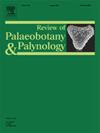First record of Cyathocarpus (Marattiales) in Gondwana: A new species from the Permian of Patagonia, Argentina
IF 1.7
3区 地球科学
Q2 PALEONTOLOGY
引用次数: 0
Abstract
Marattialean ferns were key components of Paleozoic wetland ecosystems, yet their biogeographic history in Gondwana remains poorly resolved. While Cyathocarpus is well documented from Euramerica and Cathaysia, no species had been recognized in Gondwana—until now. We describe Cyathocarpus polinensis sp. nov. from the Guadalupian La Golondrina Formation of Patagonia, Argentina, representing the first Gondwanan record of the genus. The species exhibits a distinctive arrangement of synangial rows that do not contact the midvein or pinnule margins and are consistently absent from the apical and basal regions of the pinnules. The midvein is conspicuous, straight, and divides fanwise near the apex; lateral veins bifurcate once, close to the midvein. This discovery extends the paleogeographic range of Cyathocarpus and supports a dispersal scenario from Euramerica into southern Gondwana during the Cisuralian. These findings call for a critical reassessment of comparable Gondwanan taxa and underscore the role of southwestern Gondwana as a refugium and center of marattialean diversification during postglacial climatic recovery.
冈瓦纳地区Cyathocarpus (Marattiales)的首次记录:阿根廷巴塔哥尼亚二叠纪的一新种
摘要蕨类植物是古生代湿地生态系统的重要组成部分,但其在冈瓦纳的生物地理历史仍未得到很好的解决。虽然Cyathocarpus在欧洲和华夏都有很好的记录,但直到现在,冈瓦纳还没有发现任何物种。我们描述了来自阿根廷巴塔哥尼亚Guadalupian La Golondrina组的Cyathocarpus polinensis sp. 11 .,代表了该属的第一个冈瓦纳记录。该种表现出一种独特的排列,不接触中脉或小穗边缘的同质行,并且始终不存在于小穗的顶端和基部区域。中脉明显,直,并在先端附近扇形分开;侧脉分叉一次,靠近中脉。这一发现扩大了Cyathocarpus的古地理范围,并支持了一种从欧洲到冈瓦纳南部的分布情况。这些发现要求对冈瓦纳的类群进行批判性的重新评估,并强调冈瓦纳西南部在冰川后气候恢复期间作为避难所和物种多样化中心的作用。
本文章由计算机程序翻译,如有差异,请以英文原文为准。
求助全文
约1分钟内获得全文
求助全文
来源期刊
CiteScore
3.50
自引率
21.10%
发文量
149
审稿时长
6 months
期刊介绍:
The Review of Palaeobotany and Palynology is an international journal for articles in all fields of palaeobotany and palynology dealing with all groups, ranging from marine palynomorphs to higher land plants. Original contributions and comprehensive review papers should appeal to an international audience. Typical topics include but are not restricted to systematics, evolution, palaeobiology, palaeoecology, biostratigraphy, biochronology, palaeoclimatology, paleogeography, taphonomy, palaeoenvironmental reconstructions, vegetation history, and practical applications of palaeobotany and palynology, e.g. in coal and petroleum geology and archaeology. The journal especially encourages the publication of articles in which palaeobotany and palynology are applied for solving fundamental geological and biological problems as well as innovative and interdisciplinary approaches.

 求助内容:
求助内容: 应助结果提醒方式:
应助结果提醒方式:


